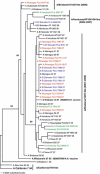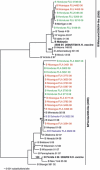Influenza and other respiratory viruses in three Central American countries
- PMID: 21306576
- PMCID: PMC4942008
- DOI: 10.1111/j.1750-2659.2010.00182.x
Influenza and other respiratory viruses in three Central American countries
Abstract
Background: Despite the disease burden imposed by respiratory diseases on children in Central America, there is a paucity of data describing the etiologic agents of the disease.
Aims: To analyze viral etiologic agents associated with influenza-like illness (ILI) in participants reporting to one outpatient health center, one pediatric hospital, and three general hospitals in El Salvador, Honduras, and Nicaragua Material &
Methods: Between August 2006 and April 2009, pharyngeal swabs were collected from outpatients and inpatients. Patient specimens were inoculated onto cultured cell monolayers, and viral antigens were detected by indirect and direct immunofluorescence staining.
Results: A total of 1,756 patients were enrolled, of whom 1,195 (68.3%) were under the age of 5; and 183 (10.4%) required hospitalization. One or more viral agents were identified in 434 (24.7%) cases, of which 17 (3.9%) were dual infections. The most common viruses isolated were influenza A virus (130; 7.4% of cases), respiratory syncytial virus (122; 6.9%), adenoviruses (63; 3.6%), parainfluenza viruses (57; 3.2%), influenza B virus (47; 2.7% of cases), and herpes simplex virus 1 (22; 1.3%). In addition, human metapneumovirus and enteroviruses (coxsackie and echovirus) were isolated from patient specimens.
Discussion: When compared to the rest of the population, viruses were isolated from a significantly higher percentage of patients age 5 or younger. The prevalence of influenza A virus or influenza B virus infections was similar between the younger and older age groups. RSV was the most commonly detected pathogen in infants age 5 and younger and was significantly associated with pneumonia (p < 0.0001) and hospitalization (p < 0.0001).
Conclusion: Genetic analysis of influenza isolates identified A (H3N2), A (H1N1), and B viruses. It also showed that the mutation H274Y conferring resistance to oseltamivir was first detected in Honduran influenza A/H1N1 strains at the beginning of 2008. These data demonstrate that a diverse range of respiratory pathogens are associated with ILI in Honduras, El Salvador, and Nicaragua. RSV infection in particular appears to be associated with severe disease in infants in the region.
© 2010 Blackwell Publishing Ltd.
Figures




Similar articles
-
[Simultaneous detection of respiratory viruses and influenza A virus subtypes using multiplex PCR].Mikrobiyol Bul. 2014 Oct;48(4):652-60. doi: 10.5578/mb.8221. Mikrobiyol Bul. 2014. PMID: 25492660 Turkish.
-
Surveillance of respiratory viral infections among pediatric outpatients in northern Taiwan.J Clin Virol. 2004 May;30(1):81-5. doi: 10.1016/j.jcv.2003.08.014. J Clin Virol. 2004. PMID: 15072759
-
Respiratory viruses involved in influenza-like illness in a Greek pediatric population during the winter period of the years 2005-2008.J Med Virol. 2011 Oct;83(10):1841-8. doi: 10.1002/jmv.22173. J Med Virol. 2011. PMID: 21837803 Free PMC article.
-
Benign acute childhood myositis: a scoping review of clinical presentation and viral etiology.Eur J Pediatr. 2024 Nov;183(11):4641-4647. doi: 10.1007/s00431-024-05786-y. Epub 2024 Sep 25. Eur J Pediatr. 2024. PMID: 39320539 Free PMC article.
-
Viruses associated with pneumonia in adults.Clin Infect Dis. 2012 Jul;55(1):107-13. doi: 10.1093/cid/cis297. Epub 2012 Mar 15. Clin Infect Dis. 2012. PMID: 22423119 Free PMC article. Review.
Cited by
-
Sentinel surveillance of influenza-like illness in two hospitals in Maracay, Venezuela: 2006-2010.PLoS One. 2012;7(9):e44511. doi: 10.1371/journal.pone.0044511. Epub 2012 Sep 11. PLoS One. 2012. PMID: 22984519 Free PMC article.
-
The epidemiology and clinical characteristics of young children hospitalized with respiratory syncytial virus infections in Guatemala (2007-2010).Pediatr Infect Dis J. 2013 Jun;32(6):629-35. doi: 10.1097/INF.0b013e318289e3bc. Pediatr Infect Dis J. 2013. PMID: 23380666 Free PMC article.
-
Respiratory viral pathogens among Singapore military servicemen 2009-2012: epidemiology and clinical characteristics.BMC Infect Dis. 2014 Apr 15;14:204. doi: 10.1186/1471-2334-14-204. BMC Infect Dis. 2014. PMID: 24735158 Free PMC article.
-
Viral Etiology of Acute Respiratory Infections in Pediatric Patients in Lebanon.Mediterr J Hematol Infect Dis. 2019 Nov 1;11(1):e2019059. doi: 10.4084/MJHID.2019.059. eCollection 2019. Mediterr J Hematol Infect Dis. 2019. PMID: 31700584 Free PMC article.
-
Sentinel surveillance of influenza-like-illness in two cities of the tropical country of Ecuador: 2006-2010.PLoS One. 2011;6(8):e22206. doi: 10.1371/journal.pone.0022206. Epub 2011 Aug 24. PLoS One. 2011. PMID: 21887216 Free PMC article.
References
-
- Williams BG, Gouws E, Boschi‐Pinto C, Bryce J, Dye C. Estimates of world‐wide distribution of child deaths from acute respiratory infections. Lancet Infect Di 2002; 2(1):25–32. - PubMed
-
- Puzelli S, Boros S, Affinito C et al. Prevalence of antibodies against A and B influenza viruses in South‐Western Papua New Guinea. J Med Viro 2006; 78:820–824. - PubMed
-
- Gwaltney JM. Clinical significance and pathogenesis of viral respiratory infections. Am J Me 2002; 112(Suppl. 6A):13S–18S. - PubMed
-
- Heijnen ML, Dorigo‐Zetsma JW, Bartelds AI, Wilbrink B, Sprenger MJ. Surveillance of respiratory pathogens and influenza‐like illnesses in general practices ‐ The Netherlands, winter 1997–98. Euro Surveill 1999; 4(7):81–84. - PubMed
MeSH terms
LinkOut - more resources
Full Text Sources
Miscellaneous

